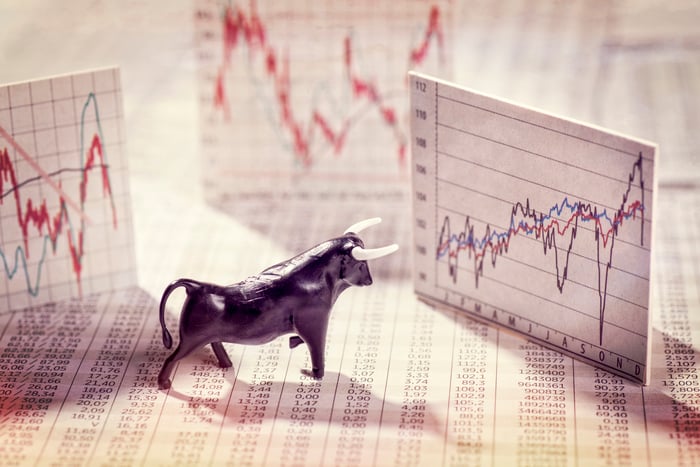Believe it or not, there are now nine publicly traded U.S. companies worth $1 trillion or more.
They are Apple, Microsoft, Nvidia, Amazon, Alphabet, Meta Platforms, Tesla, Broadcom, and Taiwan Semiconductor. Berkshire Hathaway was briefly a member of the group, but its market cap has dipped slightly below the threshold this month. Still, it seems likely that it will rise back above the mark again, effectively making the conglomerate the tenth trillion-dollar company.
Just a few years ago, there weren't any U.S. companies worth more than $1 trillion, and at the end of 2023, there were only five (the first five named on the list above).
Thanks to the artificial intelligence (AI) boom, a resilient U.S. economy, and falling interest rates, membership in the club isn't quite as exclusive as it once was. Assuming this bull market continues in 2025, there are a few more companies that could reach a $1 trillion market cap -- including these three.

Image source: Getty Images.
1. Walmart
Walmart (WMT -1.28%) has been one of the biggest surprises on the stock market over the last few years as the brick-and-mortar retail giant reinvented itself as a cohesive omnichannel business with growth avenues in e-commerce, a third-party marketplace, and advertising. Meanwhile, it performed well in the inflationary period thanks to its strength in groceries and its economies of scale, which allowed it to beat competitors on price and also pass along price increases to customers.
Walmart's market cap has more than doubled over the last three years, and the stock was up 81% year to date through Dec. 18 thanks to solid growth on the top and bottom lines. Wall Street also seems to be rerating the stock in recognition of the value of its competitive advantages. Walmart now has a market cap of $763.8 billion.
From there, its market cap would have to increase by 31% in 2025 for it to cross the $1 trillion threshold. That won't be an easy climb, especially after this year's steep rise, but it could get there.
Walmart is unlikely to deliver 31% earnings growth, but it could benefit from continued multiple expansion, as its P/E of 39.2 is still a significantly lower valuation than Costco's P/E of 57.
2. Eli Lilly
Eli Lilly (LLY -1.62%) is now the most valuable pharmaceutical company in the U.S. thanks to the strong sales of its weight-loss and diabetes drugs Zepbound and Mounjaro (both of which are brands of the same compound, the GLP-1 inhibitor tirzepatide). It nearly reached a $1 trillion market cap earlier this year, but broader pressure in the pharma sector sent the stock lower in the second half of the year.
Lilly is now up 32% year to date, with a market cap of $689.5 billion, meaning it would need to grow by 45% to get to $1 trillion.
However, a look at Eli Lilly's recent results shows why that's very much within reach for the company. Revenue in the third quarter rose 20% to $11.4 billion, driven by sales growth from Mounjaro and Zepbound. As those drugs have gained adoption, Lilly's profits have soared: Adjusted net income jumped by more than 1,000% year over year to $1.06 billion in the quarter. Those drugs also have a lot of potential to be big sellers outside of the U.S. as well.
The analysts' consensus estimate is that Lilly's adjusted EPS will jump from $13.15 in 2024 to $22.60 next year, but the company could easily top that forecast. If sales of its new weight-loss drugs continue to grow and its addressable market expands, a $1 trillion market cap could be within Lilly's reach.
3. JPMorgan Chase
No banks have yet reached the $1 trillion market cap level, but JPMorgan Chase (JPM -0.87%) could become the first. It's the nation's largest bank by assets, and its diversified business model across commercial and investment banking, and CEO Jamie Dimon's balanced stewardship, have given it a valuation that's head and shoulders above its competitors.
Year to date, the bank is up 35%, and its market cap is $648.6 billion. At that valuation, it would need to jump another 54% to reach $1 trillion. That might make it a long shot to hit that mark next year, but a perfect storm could be brewing for JPMorgan Chase.
First, bank investors are hopeful that the incoming Trump administration will bring a looser new regulatory framework on the antitrust front that would encourage more mergers and acquisitions. That would benefit investment banks like JPMorgan Chase. Additionally, investors are also betting that a Republican-controlled Congress and White House will cut taxes, which would favor banks by leaving more money available for investment. Finally, interest rates have remained elevated and the Fed just cut back its forecast for rate cuts next year from four to two. Higher interest rates make it easier for JPMorgan Chase to earn more money on loans.
A strong, less-regulated economy with high interest rates may be the ideal scenario for JPMorgan Chase stock. And with the stock trading a price-to-earnings ratio of 12.8, it has plenty of room for multiple expansion as well.





